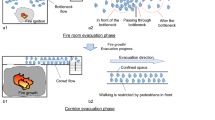Abstract
Gaining insights into pedestrian flow operations and assessment tools for pedestrian walking speeds and comfort is important for e.g. planning and geometric design of infrastructural facilities, as well as for management of pedestrian flows under regular and safety-critical circumstances. Pedestrian flow operations are complex, and vehicular flow simulation modeling approaches are generally not applicable to pedestrian flow modeling.
This paper focusses on pedestrian walking behavior. It is assumed that pedestrians are autonomous predictive controllers that minimize the subjective predicted cost of walking. Pedestrians predict the behavior of other pedestrians based on their observations of the current state as well as predictions of the future state, given the assumed walking strategy of other pedestrians in their direct neighborhood. As such, walking can be represented by a (non-cooperative or cooperative) differential game, where pedestrians may or may not be aware of the walking strategy of the other pedestrians.
This research is funded by the Social Science Research Council (MaGW) of the Netherlands Organization for Scientific Research (NWO).
Access this chapter
Tax calculation will be finalised at checkout
Purchases are for personal use only
Preview
Unable to display preview. Download preview PDF.
Similar content being viewed by others
References
W. Daamen, P.H.L. Bovy, and S.P. Hoogendoorn. Modelling Pedestrians in Transfer Stations. Proceedings of the Pedestrian and Evacuation Dynamics Conference. Duisburg (2001).
J. M. Dabbs and N.A. Stokes. Beauty is Power: the Use of Space on the Sidewalk. Sociometry. Vol. 38, no. 4 (1975) 551–557.
C. Y. Cheung and W.H.K. Lam. Pedestrian Route Choices between Escalators and Stairways in Metro Stations. Journal of Transportation Engineering 124(3), 277–285.
M. T. Chiolek. Spatial Behaviour in Pedestrian Areas. Ekistics 268 (1978) 120–121.
W. H. Fleming and H.M. Soner. Controlled Markov Processes and Viscosity Solutions. Applications of Mathematics 25. Springer-Verlag 1993.
E. Goffman. Relations in Public: Microstudies in the Public Order. New York. Basic Books 1971.
D. Helbing. Verkehrsdynamik. Springer-Verlag 1997.
D. Helbing, I. Farkas, and T. Vicsek. Simulating Dynamical Features of Escape Panic. Nature 407 (2000) 487–490.
M. R. Hill. Spatial Structure and Decision-Making of Pedestrian Route Selection Through an Urban Environment. Dissertation Thesis. University Microfilms International 1982.
S. P. Hoogendoorn. Normative Pedestrian Flow Behaviour. Report VK2001. 002, Transportation and Traffic Engineering Section, Delft University Of Technology 2001.
S. P. Hoogendoorn and P.H.L. BovyPedestrian Route-Choice and Activity Scheduling Theory and Models. Submitted to Transportation Research B 2002.
S. P. Hoogendoorn and P.H.L. Bovy. Normative Pedestrian Behaviour Theory and Modelling. 15th International Symposium on Transportation and Traffic Theory, Sydney 2002.
S. P. Hoogendoorn. Pedestrian travel behavior in walking areas by subjective utility optimization. Transportation Research Annual Meeting. Paper nr. (2002) 02–2667.
R. Hughes. The Flow of Large Crowds of Pedestrians. Mathematics and Computers in Simulation 53 (2001).
J. Reason. Human Error. New-York: Cambridge University Press 1990.
P. N. Senevarante and J.F. Morall. Analysis Of Factors Affecting the Choice of Route of Pedestrians. Transportation Planning And Technology, 10 (1986) 147–159.
Sobel, R.S., and N. Lillith. Determinant of Nonstationary Personal Space Invasion. Journal of Social Psychology. Vol. 97 (1975) 39–45.
I.B. Stilitz. Pedestrian Congestions. In: D. Canter (ed.). Architectural Phsychology. London Royal Institute of British Architects (1970) 61–72.
Willis et al. (1979). Stepping aside: correlates of Displacements in Pedestrians. Journal of Communication. Vol. 29, no 4., 34–39.
Author information
Authors and Affiliations
Editor information
Editors and Affiliations
Rights and permissions
Copyright information
© 2003 Springer-Verlag Berlin Heidelberg
About this paper
Cite this paper
Hoogendoorn, S.P. (2003). Walker Behaviour Modelling by Differential Games. In: Emmerich, H., Nestler, B., Schreckenberg, M. (eds) Interface and Transport Dynamics. Lecture Notes in Computational Science and Engineering, vol 32. Springer, Berlin, Heidelberg. https://doi.org/10.1007/978-3-662-07969-0_27
Download citation
DOI: https://doi.org/10.1007/978-3-662-07969-0_27
Publisher Name: Springer, Berlin, Heidelberg
Print ISBN: 978-3-642-07320-5
Online ISBN: 978-3-662-07969-0
eBook Packages: Springer Book Archive




